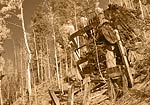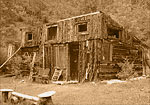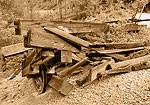



![]()
![]()
![]()
Nearly five miles south of the town of Red River lies the Black Copper Canyon and its adjacent neighbor, Fourth of July Canyon. This area is located only a few miles west of Elizabethtown so it was only natural that miners in the Moreno Valley would drift over the ridge and explore the Upper Red River Valley. When the Big Ditch was constructed in 1868, a portion of it traversed both the canyons. Many of the workers were miners from Elizabethtown, and they undoubtedly became acquainted with this entire area. Whether or not any of them prospected in the canyons is not known, but there are no records of strikes or claims from this period. It was only much later, after the town of Red River was settled and the Red River Mining District became active, that the first known gold discovery was made along Black Copper Creek. In 1896, two brothers, Neal and H. C. Garner, filed claim on what was to become the Black Copper Mine. That same year they leased it to four miners, P. H. Peterson, A. H. Lucas, Tom Sparks, and Frank Higgins. Work was carried out for several months and then in February of 1897, the big strike was made, assaying in at $100,917 a ton. This caused great excitement throughout the Red River area and prospectors rushed into both canyons. The influx of miners and the growing number of claims in the Black Copper and Fourth of July Canyons led to the formation of the Black Copper Mining District in March, with Charles Dold as president.
At the time there were no roads or trails in the area and thus no easy travel to either Red River City or Elizabethtown. In order to provide a means of shipping the ore, the new district appointed a committee to study various access routes. They decided to take advantage of the road already built from E-town to the community of Hematite, located just over the ridge from the new mining district. Using financing fro merchants in Elizabethtown, assistance from the Taos county commission, and labor from the residents of Hematite, the road was completed in June, 1897. It began in Elizabethtown, traversed up Hematite Creek to the town of Hematite and then crossed the ridge at the head of Fourth of July Canyon. From there it trailed down the canyon to reach the Upper Red River Valley, then ran south for a very short distance to Black Copper Creek. Thus, ore could now be shipped to the mill in E-town and supplies could more easily be obtained there. The major problem in all the gold mining districts was their inaccessability and the large costs of transporting ore to mills (and the smelters in Colorado). The new road tied the Black Copper Mining District to the Moreno Valley which at the time appeared to be the most logical transportation terminus. There was already stage service from Elizabethtown to many of the surrounding communities, but also access to Cimarron, Raton, and even Trinidad, Colo. There was some talk of extending the railroad from Cimarron to Elizabethtown by way of Ute Park.
About the time of completion of the new road, the Franklin Placer Company was building sluices to serve miners in the Upper Valley. They decided to take advantage of their location, being near the road at the foot of Fourth of July Canyon and only about one mile from the Black Copper Mine. Using a few cabins built for their workers, a new town was established and given the name of Franklin City. It was located near the point where the Black Copper, Fourth of July, and Bear Creeks all emptied into the Red River and there was hope that the town would serve as a supply center for the mining district. Unfortunately, it did not live up to its pretentious name, never growing beyond a few cabins, one store, and two saloons. Within a short time, it disappeared completely.
![]()


Welcome Sign

Black Copper Stamp Mill

Black Copper Bunkhouse

Collapsed Hoist Tower

Shaft Covered

Stamp Mill

